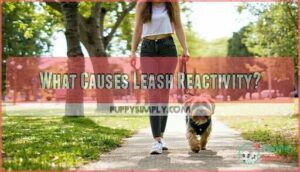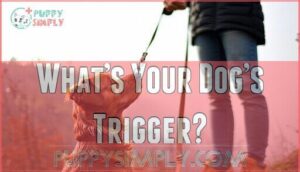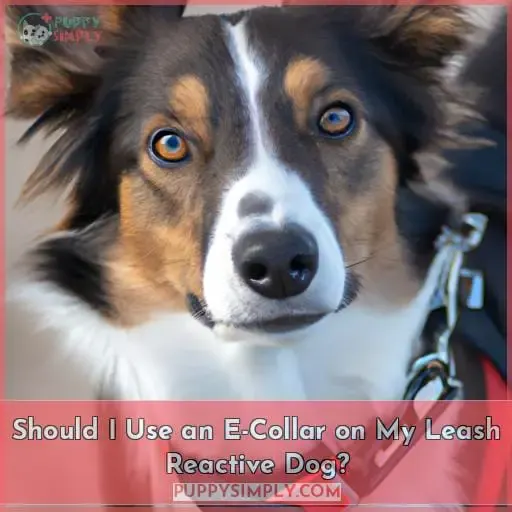This site is supported by our readers. We may earn a commission, at no cost to you, if you purchase through links.
 You’re not alone in dealing with a reactive pup!
You’re not alone in dealing with a reactive pup!
The best leash for reactive dogs provides control while avoiding aversive gear.
Try a front-attaching harness like the Ruffwear Front Range or Freedom No-Pull.
Head collars gently steer attention.
Double-handled leashes offer extra leverage.
Shock-absorbing leashes reduce jarring.
Identify your dog’s triggers and work on desensitization.
With the right leash and positive techniques, you can conquer leash reactivity together.
Want to dive deeper into managing reactivity?
The following sections provide more insights.
Table Of Contents
Key Takeaways
- Ruffwear harness and HALTI headcollar are recommended for control without neck strain.
- Identify triggers and reward calm behavior while creating distance from triggers.
- Use desensitization and counterconditioning to help dogs cope positively.
- Focus on positive reinforcement and reward calm behavior while creating distance from triggers.
What Causes Leash Reactivity?
Leash reactivity is a common issue for dogs that can be caused by fear, frustration, lack of socialization, or previous traumatic experiences. It often manifests as intense barking and lunging when the dog is on a leash and triggered by other dogs, people, or objects.
To prevent further issues from arising, it’s important to understand why your dog may be exhibiting this behavior so you can take steps to manage it correctly.
Fear and Frustration
Leash reactivity is often caused by fear and frustration, so it’s important to identify the source of these feelings in order to manage them effectively.
Socialization gaps can lead to a lack of comfort around certain triggers, while improper leash handling can cause stress and anxiety.
Fear management involves avoiding triggering situations as much as possible, but also teaching your dog how to cope with their fears through positive reinforcement, such as treats or verbal praise.
Additionally, proper body language and emotional control are essential for developing trust between you and your pup when they become overwhelmed or triggered on walks.
With patience and consistency, trigger avoidance techniques like u-turns away from other dogs/people, plus reward-based training using treats, leash reactivity can be managed successfully!
Lack of Socialization
Lack of socialization is often a major factor in leash reactivity, so it’s important to introduce your pup to new people and situations early on. Poorly socialized dogs may perceive triggers such as other animals or strangers as a threat and respond with barking or lunging when leashed.
An expert trainer can help identify trigger thresholds, desensitize below those thresholds, reward looking at the trigger rather than reacting to them, teach alternate behaviors like ‘Find It’ or ‘Watch’, move closer when calm but back up if responding badly – all while maintaining leash safety for both you and your dog.
Good socialization will reduce fear dynamics which lead to reactive behavior; don’t let poor training create an unsafe environment!
Previous Traumatic Experiences
Previous traumatic experiences can haunt your pup like a ghost, making them scared and reactive when on the leash. Fear responses to seemingly innocuous things, such as other dogs or people, may be due to past frightening events.
Socialization efforts through behavior modification and controlled leash training are important for helping your pup overcome their fears.
A head halter can help you give more control during these scary experiences, while counter conditioning is also an effective tool in managing reactions from previous traumas. Parallel walking not only helps keep owners safe but prevents further triggers of negative fear-based behavior associated with past traumatic events.
It’s essential that owners remain consistent with their approach toward addressing leash aggression in order to build trust between themselves and their pets, so they both feel secure out on walks together again soon!
What Equipment Works Best for a Reactive Dog?
Choosing the right equipment for a reactive dog is critical to ensure safety and success in training. Several options exist, including the Ruffwear Front Range Harness, Freedom Dog Harness Medium, HALTI Optifit Headcollar Medium, Hoanan Double Handle Dog Leash, and Carhartt Shock Absorbing Dog Leash.
Each of these products offers different benefits that can help you manage your dog’s reactivity while on walks or during other activities.
Ruffwear Front Range Harness
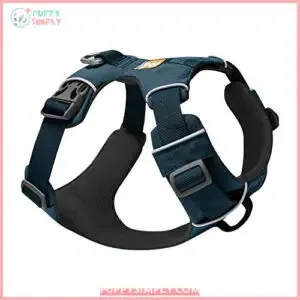
The Ruffwear Front Range Harness is the perfect way to provide control and comfort for your pooch on their outdoor adventures. It’s lightweight, durable, and features a padded chest and belly with reflective trim for visibility.
With four points of adjustment, it allows you to get just the right fit for maximum control without straining the neck or causing discomfort during long-wear activities like running or hiking.
The unisex design comes in size medium and color blue moon, making this harness suitable for most adult dogs – though make sure you measure properly as sizing can run small.
- Lightweight & Durable
- Padded Chest & Belly
- Reflective Trim For Visibility
- 4 Points Of Adjustment
- Sizing Can Run Small
- Not All Dogs Like Harnesses
Freedom Dog Harness Medium

You’ll love the Freedom Dog Harness Medium for its patented action loop that allows for straight walking without twisting or straining, and lifetime chewing warranty which replaces chewed straps. It’s also adjustable and padded to fit most breeds comfortably while providing up to 200kg tensile strength.
This no-pull harness is designed with vets in mind, as it helps align your pet’s spine during walks, reducing strain on their neck area. The edges of webbing are turned out so they don’t irritate your dog’s skin either! With a comfortable Swiss velvet lining and durable construction, you can trust this leash will stand up to everyday use from strong pullers or escape artists.
Recommended by trainers, vets, and adoption groups alike – you won’t be disappointed with the Freedom Dog Harness Medium!
- Patented action loop reduces pulling & neck strain
- Adjustable & padded design fits multiple breeds comfortably
- Durable construction stands up to daily wear & tear
- Difficult sizing for some dogs due to improper fitting, leading to slipping out of harness
- Requires continued training along with the use of the harness for best results
HALTI Optifit Headcollar Medium
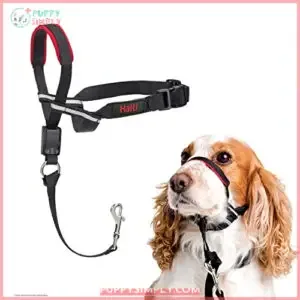
Try the HALTI Optifit Headcollar to give your pup more control without straining their neck or causing discomfort. This Company of Animals headcollar is adjustable and padded for a snug, comfortable fit that’s suitable for most breeds and face shapes.
It also features reflective strips so you can keep an eye on them in low light conditions, as well as a safety loop that attaches to their collar. Designed by Dr. Roger Mugford, it provides an effective solution when leash reactivity requires extra help during walks.
- Helps stop leash pulling
- Provides more control over the dog on walks
- Offers a comfortable fit for most dogs
- Easy to put on and adjust
- Lasts a long time if not chewed
- Material can tear if chewed
- Fastenings may fail if pulled hard
- Some dogs can get it off or move it
- Doesn’t work for all dogs/skull shapes
- Needs additional training
With the correct fitting, supervision while wearing, and additional obedience training, this product could be the right tool to set up success with managing your pup’s reactivity issues while out walking!
Hoanan Double Handle Dog Leash
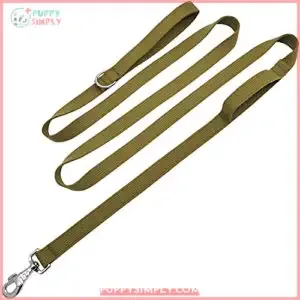
Experience enhanced control and comfort with the Hoanan Double Handle Dog Leash, a durable and versatile strap perfect for pooches of all sizes. This 2.5m nylon leash boasts sturdy stitching and a 200kg tensile strength, making it suitable for training dogs of any size or breed.
Whether you’re walking around the park or out in the field hunting, this leash is up to the task.
You can easily attach the leash to a vest, harness, or collar using its metal trigger claw clasp and adjustable D-ring. It comes in two color options – black and coyote brown – so you can choose the one that suits your pup’s style.
While this leash is reliable overall, some users have reported issues with the clasps popping open unexpectedly during use. Additionally, controlling larger breeds may require more grip than what is provided by this leash due to its length of 8ft.
- Sturdy stitching and 200kg tensile strength
- Versatile and durable design suitable for any breed/size dog
- Metal trigger claw clasp and adjustable D-ring
- Two color options: Black and Coyote Brown
- Some reports of clasps opening unexpectedly during use
- Length may not provide enough grip when controlling large breeds
Carhartt Shock Absorbing Dog Leash
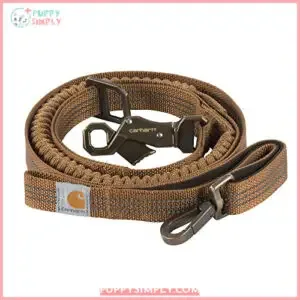
Feel the benefits of Carhartt’s Shock Absorbing Dog Leash while on your walks with your pup! This durable and reliable 6′ long leash is made from strong nylon webbing with a canvas weave and reflective stitching.
The elastic shock control zone reduces jolting, giving you more control over sudden movements.
Plus, the rugged metal trigger claw clasp and adjustable D-ring make it easy to attach to any collar or harness. The only color available in this product is Carhartt Brown, which makes it perfect for outdoor activities.
However, some may find its length too long for their preferences, as well as having an additional buckle attachment at one end that could get in the way if not used properly.
- Durable & Reliable materials
- Soft but strong material
- Length provides good control
- Reflective stitching good for low light
- Attachment clasps are sturdy & easy to use
- Shock absorbing feature reduces jolting/pulling
- Matches other Carhartt products in color
- Buckle attachment can get in the way if not used
- Limited availability of colors
- Replacement parts difficult due to shipping from USA
- Length may be too long for some owners’ preference
What’s Your Dog’s Trigger?
Identifying the triggers that set off your dog’s reactive behavior is an important first step in creating a successful training plan. Once you have identified possible triggers, it is helpful to understand your dog’s threshold distance – the point at which he begins to react and becomes aroused.
Desensitization and counter-conditioning techniques can then be used to help him cope with these situations in a positive way.
Identifying Triggers
Identifying what sets off your dog’s behavior can help you create a plan to manage it. Reward positive behavior and create distance between triggers as soon as reactive responses are triggered. Utilize calming techniques like head halters or front clip harnesses, emergency management plans with pre-arranged exits, and consistent training for long-term behavior modification in order to achieve the desired results with leash reactivity in dogs.
A good leash for such purpose is essential; look into options that offer control without straining the neck while fighting against escape artists! With patience and consistency, you can calm down even highly reactive dogs!
Understanding Threshold Distance
Determining your dog’s threshold distance is key to managing their leash reactivity. This helps you understand when they become uncomfortable and what steps need to be taken. Practice indoors with no triggers. Reward looking at the trigger from a safe distance.
Move closer only when calm, back up if reacting. Take training outdoors gradually.
When done correctly, this behavior modification technique can help create a safe environment for your pet. It also teaches them better responses towards triggers through reward systems and canine psychology principles.
Desensitization and Counter-Conditioning
Gently encourage your pup to take small steps towards triggers, rewarding them with treats and praise when they stay calm. Leash walking is an important part of desensitization and counter-conditioning for reactive dogs.
Utilize calming signals such as turning away from the trigger or sniffing the ground. Reward-based training can help reduce stress levels while teaching alternative behaviors. Develop a comprehensive plan involving environmental management, classical conditioning (associating something positive with triggers), and clicker training at your own pace.
This may include finding items in the environment or having them watch people pass by without lunging.
Should I Use an E-Collar on My Leash Reactive Dog?
Deciding whether to use an e-collar on your leash-reactive dog can be a difficult decision. Weighing the pros and cons of this training method, as well as exploring alternative methods, is important when considering how best to help your pup react safely in public spaces.
Here, we look at both sides of using e-collars for leash-reactive dogs and explore other options that may work better for you and your pet.
Pros and Cons of E-Collars
So, you may be considering an e-collar for your pup’s leash reactivity – let’s weigh up the pros and cons.
An e-collar can provide a level of control to help with reactive behaviors. However, it’s important to understand how they work and their safety protocols before using one.
E-collars are designed to cause discomfort when used correctly, but they should never be set at high levels that will cause pain or injury. It’s essential that owners seek out training courses or books on proper use, as well as reward methods for positive reinforcement behavior modification, rather than trying to pick fights with their dogs by seeking conflict through negative punishment only via the collar itself.
With careful selection of an appropriate online course or book, along with practicing safety measures while using these collars, dog owners can successfully modify their pet’s reactions in a humane way without causing additional fear or anxiety in them during training sessions.
Alternative Training Methods
Rather than relying on e-collars, explore alternative training methods that focus on desensitizing and rewarding your dog to help manage their leash reactivity. Avoid punishment and instead focus on changing the emotional response towards triggers.
- Identify the trigger threshold distance.
- Desensitize your dog below the threshold.
- Reward your dog for looking at the trigger.
- Move closer to the trigger when your dog is calm, and back up if they react.
- Teach alternate behaviors such as find it, watch, and touch.
Have an exit plan in place with barriers such as parked cars or teach a u-turn away from the trigger using a reinforced leash.
With time and consistency, you can reduce your dog’s negative reaction towards leashing without resorting to punishing them.
Need More Help?
If you’re still having trouble managing your leash-reactive dog, seeking professional training or joining support groups and classes can be beneficial. Professional trainers are experienced in developing desensitization and counterconditioning plans to help dogs become more comfortable around triggers on the leash, while supportive communities of owners allow for a better understanding of common problems and solutions.
By reaching out for additional assistance, there is hope that your pup’s reactivity issues can improve over time.
Seeking Professional Training
It’s time to get serious about your reactive dog and seek out professional training. A skilled trainer can help you create a socialization plan, teach calming techniques, and modify behavior with positive reinforcement.
Finding the right support is essential; look for someone who specializes in working with leash reactive dogs and use reviews from other pet parents to make sure they are experienced.
| Socialization Strategies | Positive Reinforcement | Calming Techniques | Behavioral Modification |
|---|---|---|---|
| Exposure Therapy | Treats | Massage | Reward-based Training |
| Desensitizing Exercises | Clickers |
Joining Support Groups or Classes
Joining a support group or taking an obedience class can provide the guidance and community you need to help your pup feel at ease around other dogs, people, and objects. Connecting with families in similar situations is beneficial for sharing experience tips.
When picking knowledgeable coaches, make sure they understand how to manage group dynamics while building friend networks for your pup. Class activities should be enjoyable so that learning becomes fun, which helps alleviate behavioral issues faster than individual sessions alone.
Ultimately, these classes are designed to teach owners effective ways of communicating with their pups, as well as providing them socialization opportunities within a safe environment!
Frequently Asked Questions (FAQs)
What is the best way to manage leash reactivity?
Manage leash reactivity with safety, skill, and savvy. Start by identifying triggers, then desensitize them at a safe distance. Reward calm behavior while teaching alternate behaviors like ‘find it’, ‘watch’, or ‘touch’.
Use front-clip harnesses for control; avoid shock collars or retractable leashes.
How can I tell if my dog is leash reactive?
Does your pup bark and lunge when on a leash? It’s as if they’re walking in quicksand, trapped by their own fear. Look for telltale signs like cowering or attempting to back away from triggers that can indicate leash reactivity.
How often should I practice leash reactivity training?
Practice leash reactivity training consistently for the best results. Start with short sessions, gradually increasing length and difficulty over time. Make sure to reward successes and pay attention to triggers so you can adjust the exercises accordingly.
Should I ever use punishment to address leash reactivity?
No, punishment is not recommended when addressing leash reactivity. It can lead to increased fear and frustration in your dog, resulting in a worsening of the problem.
What type of environment is best for leash reactivity training?
For leash reactivity training, it’s best to start indoors with no triggers and gradually move closer when your dog is calm. Use a front clip harness for control and reward looking at the trigger rather than reacting.
Have an exit plan in place if needed, use barriers like parked cars, and focus on changing their emotional response without punishment or harsh corrections.
Conclusion
You may be at your wit’s end trying to figure out the best leash for your reactive dog. When it comes to leash reactivity, the key is to recognize triggers, understand threshold distances, and desensitize and counter-condition your pup.
An appropriate leash for a reactive dog is an important part of this. The Ruffwear Front Range Harness, Freedom Dog Harness, HALTI Optifit Headcollar, Hoanan Double Handle Dog Leash, and Carhartt Shock Absorbing Dog Leash are all great options for providing control and safety.
And if you need more help, don’t be afraid to seek professional training and join support groups. With the right support and equipment, you can help your reactive dog become a calm and happy companion.

